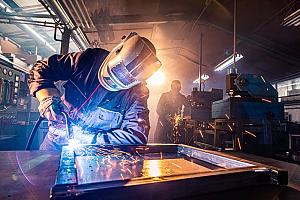Owner, Brown Dog Welding
- FMA
- The Fabricator
- FABTECH
- Canadian Metalworking
Categories
- Additive Manufacturing
- Aluminum Welding
- Arc Welding
- Assembly and Joining
- Automation and Robotics
- Bending and Forming
- Consumables
- Cutting and Weld Prep
- Electric Vehicles
- En Español
- Finishing
- Hydroforming
- Laser Cutting
- Laser Welding
- Machining
- Manufacturing Software
- Materials Handling
- Metals/Materials
- Oxyfuel Cutting
- Plasma Cutting
- Power Tools
- Punching and Other Holemaking
- Roll Forming
- Safety
- Sawing
- Shearing
- Shop Management
- Testing and Measuring
- Tube and Pipe Fabrication
- Tube and Pipe Production
- Waterjet Cutting
Industry Directory
Webcasts
Podcasts
FAB 40
Advertise
Subscribe
Account Login
Search
Wearable CNC machine offers glimpse into future of the trades
British engineering student designs, builds device to augment digital fabrication
- By Josh Welton
- June 22, 2024

British engineering student Jasper Mallinson has designed and built a wearable CNC machine that offers a glimpse into the future of the trades.
There’s a quote from computer scientist and University of Washington professor Pedro Domingos that perfectly sums up the rapid growth of technology:
“It’s not man vs. machine; it’s man with machine vs. man without. Data and intuition are like horse and rider, and you don’t try to outrun a horse; you ride it.”
In that case, Jasper Mallinson is a freaking cowboy. But he doesn’t just ride the horse, he wears it.
Let me explain.
Mallinson is a British product design engineer and student at the Royal College of Art and Imperial College London. In his final project in the school’s Innovation Design Engineering master’s course, he designed and built a wearable CNC machine, which offers welding capabilities.
It offers a fascinating look into the future of the trades as humans become more than just human with mechanical and computational augmentation. The architecture, interiors, and design website dezeen.com has the story:
Mallinson described the device as "a one-handed exoskeleton for superhuman precision.” The design came from his exploration into how digital fabrication technologies could augment rather than replace human-making abilities. "Instead of thinking about digital fabrication as something separate to human makers, I wanted this combination of the two to become the core of my project.”
I suffer from chronic health issues in my arms, and it’s only exacerbated by wear and tear. I’ve often thought about some kind of robo-arm that could replace my own flesh and blood—some sort of gnarly appendage made of titanium and carbon fiber that makes Transformer noises as I gear up for action. I’d have torch, hammer, impact, and drill attachments—the usual.
"I wanted to lean into the idea of a universal making machine, something ultimately flexible that could be used with almost any tool and augment almost any making process," Mallinson told dezeen.com.
Looks like we’re on the same page.
The Mecha-morphis, as he calls his wearable CNC machine, is far from its final form. From what I’ve read in conjunction with my real-life experiences, dialing into a datum point for a mobile CNC operation is still a process.
With AI creating ideal organic forms, fabrication is changing. Mallinson’s attention was caught by a project where Princeton University and the architectural studio SOM worked together on designing and building a parametric brick arch on the college’s campus. The bricklaying needed to be exact. So they used augmented reality, and the bricklayers wore goggles that directed them where exactly to set the pieces during construction.
Mallinson is looking to add augmented reality to the Mecha-morphis for quickly and precisely locating where the work needs to be done.
I’m stoked about this, especially as someone who has long banged the drum for a man-plus-machine future.
subscribe now

The Fabricator is North America's leading magazine for the metal forming and fabricating industry. The magazine delivers the news, technical articles, and case histories that enable fabricators to do their jobs more efficiently. The Fabricator has served the industry since 1970.
start your free subscriptionAbout the Author

- Stay connected from anywhere

Easily access valuable industry resources now with full access to the digital edition of The Fabricator.

Easily access valuable industry resources now with full access to the digital edition of The Welder.

Easily access valuable industry resources now with full access to the digital edition of The Tube and Pipe Journal.
- Podcasting
- Podcast:
- The Fabricator Podcast
- Published:
- 06/25/2024
- Running Time:
- 64:35
Matt Brunner, co-founder and co-owner of Manitowoc, Wis.-based Brunner Fabrication joins us to talk about how he transformed...
- Industry Events
Precision Press Brake Certificate Course
- July 31 - August 1, 2024
- Elgin,
Laser Welding Certificate Course
- August 6 - 8, 2024
- Farmington Hills, IL
Golf 4 Manufacturing
- August 19 - 18, 2024
- Waukegan,
The Fabricator's Technology Summit
- August 20 - 21, 2024
- Eglin, IL
































